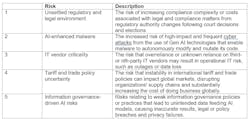Unsettled Regulatory, Legal Environment Are Risks in Q1
In the first quarter of 2025, companies have ranked unsettled regulatory and legal environment as top ranked emerging risks, according to a Gartner, Inc. survey.
The survey of 266 senior risk and assurance executives noted that increasing compliance complexity and costs due to regulatory authority changes have caused these rankings to move from the third most cited spot in 3Q24 and 4Q24 to rank as the most cited in 1Q25.
"The global political arena is seeing transformative shifts, driven by elections that have ushered new governments into power across key economies, making the issue one that executives want to better understand and address before they face real consequences,” said Gamika Takkar, director, research, key initiative leader for the Gartner Risk & Audit practice, in a statement.
Root Causes of the Unsettled Regulatory and Legal Environment
In addition to the unsettled regulatory and legal environment after the U.S. election, Europe and other regions are preparing for consequential elections that could also reshape regulatory landscapes. These political transitions carry the potential to redefine compliance frameworks, posing challenges for businesses striving to adapt to new legal realities.
Adding to the complexity is the divergent approach to artificial intelligence (AI) regulation across regions. While some governments champion AI innovation through flexible regulatory measures, others intensify scrutiny, complicating the compliance landscape for companies operating globally. This regulatory tug-of-war leaves businesses grappling with the challenge of aligning their AI strategies with disparate legal requirements.
Potential Consequences
The consequences of an unsettled regulatory and legal environment affect every aspect of business operations. As new administrations take the helm, the focus on regulatory scrutiny and enforcement can shift dramatically. In certain jurisdictions, rules that were once rigorously enforced may fall by the wayside, leaving businesses in a state of flux as they attempt to anticipate and respond to these changes.
The financial burden of compliance is also evolving as different standards across borders reshape the cost landscape. Companies may be compelled to hire specialized staff or adapt their operations to adhere to varying regulations. This financial strain can impact profitability, forcing businesses to reevaluate their strategies and resource allocation in the face of mounting compliance costs.
Assessing Risk Exposure and Navigating Policy Uncertainty
To effectively navigate these challenges, organizations should assess their risk exposure in four critical policy areas:
- Trade, tariffs, and supply chain disruptions: Companies must prepare for critical input shortages, retaliatory tariffs, shifts in trade routes, increased production costs, capital investment uncertainty, exchange rate volatility, and lower consumer demand.
- Regulatory and legal volatility: Rapid changes in industry-specific regulations, uncertain legal and compliance costs, shifting tax policy, changes in federal spending, and evolving AI regulation require vigilant monitoring and adaptation.
- Shifting geopolitical landscape: Reduced government spending on foreign aid, employee safety concerns, business continuity challenges, and critical shipping lane disruptions necessitate strategic planning and risk mitigation efforts.
- Immigration and workforce changes: Shifting talent availability, productivity losses, weakened critical expertise, labor cost uncertainty, and legal and compliance changes demand agile workforce strategies.
“Businesses can better position themselves to adapt to these emerging threats by prioritizing potential disruptions and shifting resources to mitigate risks,” said Takkar.

